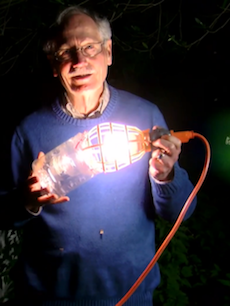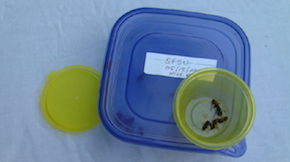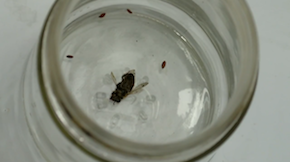'ZomBee' hunters needed
ZomBee season is here! The summer months are an ideal time to observe pollinators, as well as their parasites. Collecting and reporting bees that appear infected is a summer project that could have a national impact.
Professor of Biology John Hafernik and his colleagues launched the ZomBeeWatch.org website last year to encourage citizen scientists to report cases of honey bees infected by a phorid fly parasite. Infected bees abandon their hives to congregate at night near lights, dying after a bout of disoriented, “zombie-like” behavior.
Professor of Biology John Hafernik holds a homemade light trap, perfect for attracting ZomBees. (Click photo to 'Become a Zombee Hunter')
Hafernik first discovered the infected bees on the SF State campus. Since then, nearly 100,000 people have visited the ZomBee Watch site, and 1,470 ZomBee hunters have registered to submit their data on possible honey bee infections. About a quarter of the participants are beekeepers, while the rest are interested citizens doing their part to help track this new threat to honey bees.
Thanks to their efforts, new cases in the ZomBee outbreak have been confirmed at several sites along the coast in the Pacific Northwest, Hafernik said. “So far we’ve recorded positive samples of parasitized bees from Santa Barbara in the south all the way to Seattle in the north.”
ZomBeeWatch.org wants to expand website registration to more volunteers and encourage already registered users to log back in and update the fate of their zombie-bees. Although the majority of parasitized bees have been found along the western U.S. coast, the fly parasite is also native to more inland places such as eastern and central North America, where honey bees are a possible new host.
Hafernik said some observers may not be reporting “negative” cases in their neighborhoods -- that is, instances where the honey bees are collected but not parasitized by the flies. “Not finding something is hard to interpret,” he admits, “but it’s useful information for us. Even if the fly maggots do not emerge from the honey bees, that is important information for the scientists that track this new parasite.”
ZomBee hunters should safely collect and store potentially infected honeybees. (Click photo to 'Become a Zombee Hunter')
Each observation allows the researchers to develop a more complete map of where and when the parasites are infecting bees. But this map depends on ZomBee Watch participants completing their observations by recording whether or not parasitic pupae emerge from their bees. Patience is vital to useful scientific observation. Hafernik says, “One of our challenges is that this project requires a person to make observations for up to a week for each sample.”
Hafernik wants citizens scientists “to start thinking about bees that are acting strangely again,” since ZomBee infestations tend to peak in the late summer into fall, continuing into the earliest winter months.
“If I were a fly, I’d want to peak in the spring and early summer,” Hafernik said. “When bees are really thriving and bringing in a lot of pollen and nectar…but that’s not the pattern we’re seeing.”
It could be that the honey bees are too healthy in the spring and early summer to be infected, he suggested, “but we don’t know what their defense would be against the parasite, if they have one.”
Approximately seven days after an infected bee dies, parasitic fly pupae should emerge. (Click photo to 'Become a Zombee Hunter')
Scientists do not know why parasitized bees become ZomBees. “We still don’t know if this phorid fly is manipulating its host bee, or if this is just a byproduct of parasitism,” Hafernik said. This summer and fall, SF State physiology researcher Christopher Moffatt and his graduate students will look at the underlying causes of ZomBee behavior.
The phorid fly may not be the only insect parasitizing bees. People in various parts of the U.S. have reported seeing honey bees coming to lights, but the bees did not test positive for the fly parasite. “It’s intriguing as to what’s going on with that as well,” Hafernik said, “that there are potentially other actors in this drama that may be causing bees to be out at night.”
Hafernik is working with SF State computer science students (with the leadership of Computer Science Department Chair Dragutin Petkovic) to update the ZomBee Watch website with more features, including auto reminders and emails, to encourage participants to keep up the hunt for parasitized honey bees.
“We’re still cautious at this point about the extent and damage of infestation,” he said, “and we don’t know what to expect next.”
Learn more by watching a new series of videos designed to help Zombee hunter recruits:
Zombee Watch: Become a Zombee hunter
Zombee Watch: How to build a light trap
Zombee Watch: Report your data


